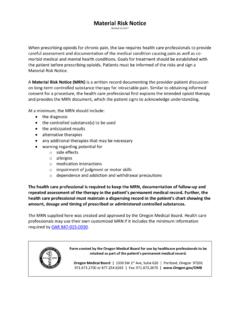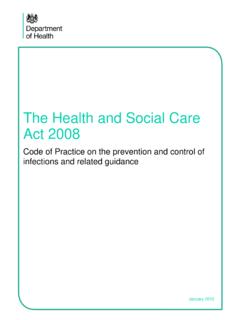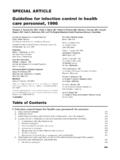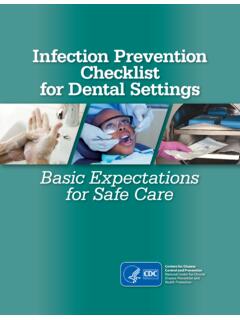Transcription of Interim Guidance for Managing Healthcare Personnel with ...
1 1 of 4 OHA (02/18/2022) PUBLIC HEALTH DIVISION Acute and Communicable Disease Prevention Kate Brown, Governor 800 NE Oregon St, Suite 772 Portland, OR 97232 Voice: 971-673-1111 Fax: 971-673-1100 Date: Feb 18, 2022 Interim Guidance for Managing Healthcare Personnel with SARS-CoV-2 Infection or Exposure The information contained herein supersedes previous Guidance related to returning to work after SARS-CoV-2 infection or exposure in Healthcare settings. Background Due to concerns about increased transmissibility of the SARS-CoV-2 Omicron variant, this Guidance is being updated to enhance protection for Healthcare Personnel (HCP), patients, and visitors, and to address concerns about potential impacts on the Healthcare system given a surge of SARS-CoV-2 infections .
2 These updates will be refined as additional information becomes available. Summary of recent changes: Updated text in Guidance to include links to CDC s definition of what it means to be up to date with all recommended COVID-19 vaccine doses. In general, asymptomatic HCP who have recovered from SARS-CoV-2 infection in the prior 90 days do not require work restriction following a higher-risk exposure. Return to Work Criteria for HCP with SARS-CoV-2 Infection The following are criteria to determine when HCP with SARS-CoV-2 infection could return to work. After returning to work, HCP should self-monitor for symptoms and seek re-evaluation from occupational health if symptoms recur or worsen.
3 Either an antigen test or nucleic acid amplification test (NAAT) can be used. Conventional return-to-work criteria are as follows: Symptomatic HCP At least 7 days have passed since symptoms first appeared if HCP had a negative test within 48 hours prior to returning to work (or 10 days have passed if testing is not performed or if HCP had a positive test at day 5-7), and At least 24 hours have passed since last fever without the use of fever-reducing medications, and Symptoms ( , cough, shortness of breath) have improved. 2 of 4 OHA (02/18/2022) Asymptomatic HCP At least 7 days have passed since the date of the HCP s first positive test if HCP had a negative test within 48 hours prior to returning to work (or 10 days if testing is not performed or a positive test at day 5 7).
4 Additional considerations for HCP with severe illness or who are moderately to severely immunocompromised can be found in CDC Return to Work Guidance . Return to Work Criteria for HCP Who Were Exposed to Individuals with Confirmed SARS-CoV-2 Infection This Guidance does not supplant the need for HCP with even mild symptoms of COVID-19 to be prioritized for viral testing. HCP who become symptomatic or test positive for COVID-19 should follow Return to Work Criteria for HCP with SARS-CoV-2 Infection. Recommended Work Restrictions for HCP Based on Vaccination Status and Type of Exposure Exposure Category HCP who are up to date with all recommended COVID-19 vaccine doses HCP who are not up to date with all recommended COVID-19 vaccine doses Higher-risk No work restrictions.
5 Testing is recommended immediately (but generally not earlier than 24 hours after the exposure) and, if negative, again 5 7 days after the exposure. Exclude from work for 10 days after the exposure OR Exclude from work for 7 days with negative test collected 5-7 days after the exposure. Lower-risk No work restrictions or testing. HCP should continue to monitor for fever or symptoms consistent with COVID-19. HCP who have had prolonged close contact with someone with SARS-CoV-2 in the community ( , household contacts) should be managed as described for higher-risk occupational exposures above. Asymptomatic HCP who have recovered from SARS-CoV-2 infection in the prior 90 days do not require work restriction and are not required to be tested following a higher-risk exposure; however, if testing is performed on these HCP, antigen test instead of molecular ( , NAAT) is preferred.
6 Other circumstances when work restriction might be recommended include: 1. When HCP are moderately to severely immunocompromised. 2. When directed by public health authorities ( , during an outbreak in which SARS-CoV-2 infections are identified among HCP who have received all COVID-19 vaccine doses, including booster dose, as recommended by CDC). In the event of ongoing transmission within a facility that is not controlled with initial interventions, strong consideration should be given to restriction from work of HCP with higher-risk exposures who have received 3 of 4 OHA (02/18/2022) all COVID-19 vaccine doses, including booster dose, as recommended by CDC.
7 In these and other circumstances, the jurisdiction s public health authority may recommend additional precautions. Contingency & Crisis Strategies to Mitigate Staffing Shortages Healthcare facilities may employee contingency and crisis-level strategies to address staffing shortages. Contingency and crisis-level strategies and considerations for their implementation are detailed in CDC s Strategies to Mitigate Healthcare Personnel Staffing Shortage Guidance . Definitions of contingency and crisis strategies are provided below. Healthcare facilities should employ a sequential approach, noting that escalating to contingency or crisis tiers increases the risk of spread in Healthcare settings if not implemented with broad infection control measures.
8 Such measures include universal use of well-fitting masks in Healthcare settings, frequent environmental disinfection, ventilation, hand hygiene, and physical distancing in the workplace. Special attention should be given to infection prevention in areas ( , nursing stations, meal and break rooms) where spread among Healthcare workers is most likely to occur. Facilities should discuss the use of crisis-level strategies with their LPHA and licensing agency to ensure they have exhausted available options and resources. Once facilities move to implement contingency- or crisis-level strategies, it is strongly recommended that they 1) educate all HCP in the universal use of well-fitting masks at all times when in the facility; and 2) ensure that these masks are readily accessible to HCP for voluntary use.
9 N95 (NIOSH-approved) filtering facepiece respirators are the best option for well-fitting protection, but KN95s or medical procedure masks that are adjusted to provide a better fit to the face are also an option. Oregon OSHA does not require fit testing or a medical evaluation for the voluntary use of an N95 filtering facepiece respirator. However, facilities must ensure that when HCP use any respirator it is done in accordance with Oregon OSHA s requirements and workplace advisory memo Additional information on Oregon OSHA s COVID-19 rule, and their respiratory protection standard can be found at Definitions Healthcare setting: Refers to any place where health care, including physical or behavioral health care, is delivered and includes, but is not limited to any health care facility or agency licensed under ORS 441 and 443, such as hospitals, ambulatory surgical centers, birthing centers, special inpatient-care facilities, long-term acute-care facilities, inpatient rehabilitation facilities, inpatient hospice facilities, nursing homes and assisted-living facilities, home health care, hospice, in-home care, vehicles or temporary sites where health care is delivered ( , mobile clinics, ambulances)
10 , and outpatient facilities, such as dialysis centers, physician offices, dental clinics, urgent-care centers, counseling offices, offices that provide complementary and alternative medicine such as acupuncture, homeopathy, naturopathy, chiropractic and osteopathic medicine, and other specialty centers. 4 of 4 OHA (02/18/2022) Healthcare Personnel (HCP): Refers to paid and unpaid persons serving in health care settings who have the potential for direct or indirect exposure to patients or potentially infectious materials, including body substances ( , blood, tissue and specific body fluids) and includes, but is not limited to, emergency medical service (EMS)













